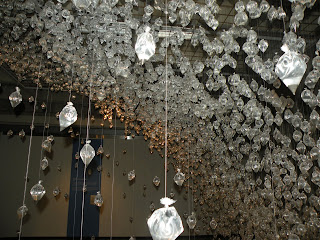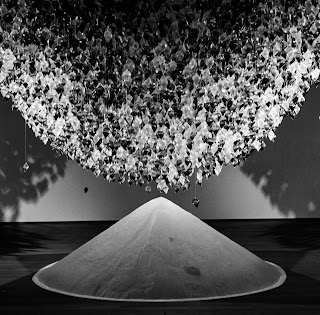ARTIST'S STATEMENT
I grew up in a society where the people care less about what happens to the environment. People tend to fend for themselves in isolation, without considering the environment as an integral part of their lives. In his book “Ecopsychology, Restoring the Earth, Healing the Mind”, Theodore Roszak quoted Freud: “Normally, there is nothing of which we are more certain than the feeling of ourselves, of our own ego. This ego appears as something else…” and he still holds that “this ego seems to maintain clear and sharp line of demarcation.” But I think this demarcation is so unfair in the sense that we are guilty of the cause of the environmental sickness.
We are only destroying a permanent feature and support of our existence to enjoy a temporary and artificial one. This is because we do not consider the answers to these questions posited by James Hillman’s article, A Psyche the size of the Earth, in Theodora Roszak’s Ecopsychology: “Where is the ‘me’? Where does the ‘me’ begin? Where does the ‘me’ stop? Where does the ‘other’ begin?”We have continued to produce and consume a lot of toxic and dangerous chemicals that cause the deterioration of the Earth: water and air pollution, deforestation, acid rain, endangered species etc. simply because we do not care. I just wonder why it is in the nature of man to be ruthless, and I am afraid he does not seem to be scared of this impending ecologal crisis. The question is “who is the culprit?” Well, in trying to answer this question, all fingers point at Modernism. It is the Modernist view to see art as an arena in which to pursue individual freedom and expression, with more emphasis on aesthetics. This reminds me of a statement by Suzi Gablik in The Re-enchantment of Art: “…whereas the aesthetic perspective oriented us to the making of object, the ecological perspective connects art to its integrative role in the larger whole and the web of relationships in which art exists”. It becomes so interesting to hear that some other people are beginning to think about ‘The Re-enchantment of Art’, “...the emerging new paradigm reflects a will to participate socially: a central aspect of new paradigm thinking involves a significant shift from objects to relationships…there is a need for new forms emphasizing our essential interconnectedness rather than our separateness, forms evoking the feeling of belonging to a larger whole rather than emphasizing the isolated, alienated self.” (Gablik: 1991). It is high time we changed our notion of ‘Modernist individual freedom’, which only meant freedom from community, freedom from obligation to the world, and freedom from relatedness. To face a more resilient approach, according to Gablik, “a new emphasis falls on community and the environment rather than on individual achievement and accomplishment”. Will it not pay us to consider what Morris Berman in the Re-Enchantment of the World says: “…if there is any bond among the elements of this ‘counter culture’, it is the notion of recovery… of our bodies, our health, our sexuality, our natural environment, our archaic traditions, our unconscious mind, our rootedness in the land, our sense of community, and our connectedness to one another” (Gablik: 1991).
In another note, it is my strong conviction that every generation owes an obligation to history. The ancient civilization played their parts well by making and preserving their material histories. The gatherers, the cavemen and their art, the hunters, the blacksmiths, the farmers, enjoyed the natural world. But would the modernists’ history be that they destroyed the existing history with their hyper civilization? I believe this is what informed Suzi Gablik’s book ‘Modernism has failed’. Well, let us see what shall become of the history of postmodernism…
It is on this basis that I work on my ECO-SCOPE, a concept that informs my artistic expression.
We are only destroying a permanent feature and support of our existence to enjoy a temporary and artificial one. This is because we do not consider the answers to these questions posited by James Hillman’s article, A Psyche the size of the Earth, in Theodora Roszak’s Ecopsychology: “Where is the ‘me’? Where does the ‘me’ begin? Where does the ‘me’ stop? Where does the ‘other’ begin?”We have continued to produce and consume a lot of toxic and dangerous chemicals that cause the deterioration of the Earth: water and air pollution, deforestation, acid rain, endangered species etc. simply because we do not care. I just wonder why it is in the nature of man to be ruthless, and I am afraid he does not seem to be scared of this impending ecologal crisis. The question is “who is the culprit?” Well, in trying to answer this question, all fingers point at Modernism. It is the Modernist view to see art as an arena in which to pursue individual freedom and expression, with more emphasis on aesthetics. This reminds me of a statement by Suzi Gablik in The Re-enchantment of Art: “…whereas the aesthetic perspective oriented us to the making of object, the ecological perspective connects art to its integrative role in the larger whole and the web of relationships in which art exists”. It becomes so interesting to hear that some other people are beginning to think about ‘The Re-enchantment of Art’, “...the emerging new paradigm reflects a will to participate socially: a central aspect of new paradigm thinking involves a significant shift from objects to relationships…there is a need for new forms emphasizing our essential interconnectedness rather than our separateness, forms evoking the feeling of belonging to a larger whole rather than emphasizing the isolated, alienated self.” (Gablik: 1991). It is high time we changed our notion of ‘Modernist individual freedom’, which only meant freedom from community, freedom from obligation to the world, and freedom from relatedness. To face a more resilient approach, according to Gablik, “a new emphasis falls on community and the environment rather than on individual achievement and accomplishment”. Will it not pay us to consider what Morris Berman in the Re-Enchantment of the World says: “…if there is any bond among the elements of this ‘counter culture’, it is the notion of recovery… of our bodies, our health, our sexuality, our natural environment, our archaic traditions, our unconscious mind, our rootedness in the land, our sense of community, and our connectedness to one another” (Gablik: 1991).
In another note, it is my strong conviction that every generation owes an obligation to history. The ancient civilization played their parts well by making and preserving their material histories. The gatherers, the cavemen and their art, the hunters, the blacksmiths, the farmers, enjoyed the natural world. But would the modernists’ history be that they destroyed the existing history with their hyper civilization? I believe this is what informed Suzi Gablik’s book ‘Modernism has failed’. Well, let us see what shall become of the history of postmodernism…
It is on this basis that I work on my ECO-SCOPE, a concept that informs my artistic expression.


Comments